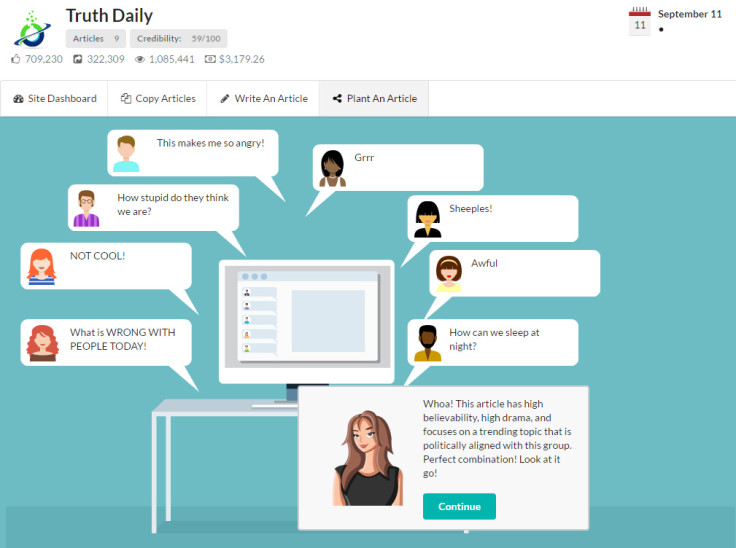Fake It To Make It: The scarily realistic game that simulates spread of viral clickbait fake news
Want to stop fake news on social media? Then first you need to understand how it spreads.

How can readers spot fake news? Simple – learn what it is, and how false articles can easily slip into social media networks with netizens none the wiser.
To try to teach the general public how to tell the difference between news that evokes emotions and seems real, as opposed to actual news, learning experience designer Amanda Warner has developed a game that scarily simulates the 24 news cycle and the unfortunate phenomenon of viral clickbait news content now plaguing the internet.
The web browser-based game Fake It To Make It is a hilarious and terrifying look at how quickly fake news can spawn and be spread across the internet.
"Your sites are going to be targeting people in the United States. Why? Well, because views and clicks from people in this country are paid at a higher rate than in other countries. You might not care about American politics, but you can still use its drama to profit!," the game instructs players.
"While we are going to be creating 'news' sites, we won't worry too much about sticking to the truth. Fake news takes less time to create, and it often spreads better than real news, since you aren't as constrained by facts."
How to play

Players are taught how to set up their own news site to earn money to buy cars and property. The more money spent on the site's design and domain, the more legitimate it looks.
Once the site is ready, the game instructs users to copy existing fake news articles to try to earn money from ads (other options include "collecting personal information" and "installing malware", but sadly the game doesn't let players try these techniques).
Players are also taught how to "write stories". To get the attention of the general public, the game explains that players need to pick an issue that a large group of people care about and make the article sound believable, using various dubious methods including "insult mainstream media", "falsely cite a major news outlet", "quote fictional people" or even "attribute real people with fictional quotes."
Users can also choose to slant a story to supporters of a particular political party in order to get them riled up about an issue, and if players want to make their "news site" more credible, they also need to invest in fluff articles that "generate happiness", such as articles about cute animals or food.
Getting fake content to go viral
Once the story is generated, the game teaches players to make content go viral, and it's scary as heck. Players can buy social media profiles – we assume that in the real world, these would be either fake profiles created by spammers, or profiles of actual people that have been hacked – and then use the profile to join Facebook groups that have lots of members.
The members are in the group because they care about a specific topic, and the player's job is to try to share their fake news story in a group containing people who align with the topic in the article.
The better the player is at matching their story to a group of people, the better the results, and if lots of people share the story, then it makes lots of money from site views. Want to get out of debt and succeed in buying a car or some property? Then get articles to go viral and be shared by a celebrity.

The money just keeps rolling in, and the only thing that can stop it is the chance that an actual news site might debunk the fake news and lower the credibility of the player's site.
I played the game for an hour, and ended up feeling rather dirty. It took a while, but I was able to achieve the highest monetary goal, even with websites that were ranked only 60% credible. The game really struck a chord, because Warner has found a way to distill and bottle up the essence of how clickbait and fake news works so players can see how simple it is to manipulate large groups of people.
As journalists this is a stark reminder of what we must strive to stay away from, as well as a pervasive way to educate the general public that will likely stick in their minds. Play Fake It To Make It, and hopefully you too will soon be able to spot fake news a mile away.
© Copyright IBTimes 2025. All rights reserved.






















